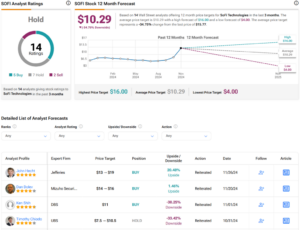SoFi Technologies: Analyzing the Risks Beneath the Surface
SoFi Technologies (SOFI), the Californian lending technology platform, has emerged as a standout player in the financial sector, boasting significant gains over the past year. However, the impressive growth narrative is coupled with a plethora of risks that could temper expectations. While many investors are riding the wave of excitement, a closer examination reveals potential pitfalls that could impact the company’s trajectory.
Eye-Watering Valuations: A Cause for Concern
At the heart of the bearish sentiment surrounding SoFi is its staggering valuation. The company’s current non-GAAP price-to-earnings (P/E) ratio sits at a staggering 114.4, a shocking 733.4% above the sector median of 13.7. Forward-looking estimates only deepen the unease, with a projected P/E of 134.6x that is 890% higher than the sector average. In simpler terms, investors are essentially banking on future earnings that may be unrealistic.
The GAAP P/E ratios draw a similar picture, indicating that the market’s high expectations may not align with achievable performance. Current earnings projections reflect high hopes for growth but come laden with risk. The estimated P/E ratios are set to decline significantly over the next few years — from 119.4x in 2024 to 25.3x in 2027 — hinting at a challenging road ahead for the company to meet these ambitious forecasts.
The Price-to-Earnings-to-Growth (PEG) Ratio and Dividend Dilemma
While SoFi’s anticipated earnings growth is pegged at an impressive average of 60% over the next few years, this optimism culminates in a price-to-earnings-to-growth (PEG) ratio of 1.99. This figure overshadows the sector average of 1.45, making the stock appear more expensive when growth is factored into the equation. Moreover, SoFi does not pay dividends like many of its financial sector peers. For income-focused investors, this absence only amplifies the attractive appeal these lofty valuations promise but may fail to deliver given execution risks.
The Bull Market: A Double-Edged Sword
SoFi’s impressive revenue tripling and overall growth have been fueled by favorable macroeconomic conditions. The past year saw a booming U.S. market, which often leads to exuberance among investors—an environment where SoFi rose by an astounding 121%. Rising interest rates and the restart of student loan payments have further bolstered the company’s revenue streams. However, this “risk-on” sentiment raises concerns; should the market margins start to narrow or political stability wane, SoFi’s performance could swiftly be recalibrated.
Deteriorating Loan Portfolio: A Red Flag
Despite exhibiting considerable revenue growth, cracks are appearing in the underlying credit quality of SoFi’s loan portfolio. Recent data shows a significant uptick in loans that are delinquent for 90 days or more, alongside a fivefold increase in loan charge-offs year-over-year reported in Q3 of 2023. This trend indicates rising financial stress among consumers, posing a serious risk to SoFi’s growth and profitability. With consumer debt levels at record highs, the company may face substantial headwinds in maintaining its growth trajectory.
Analysts’ Forecasts: Potential for Surprises
Although the outlook appears overshadowed by risk, there are glimmers of hope. Analysts show a wave of optimism, with seven out of ten revising their Earnings Per Share (EPS) estimates upward in recent months. Projections indicate that EPS could double from $0.13 in 2024 to $0.28 in 2025, reflecting a robust 111.7% growth year-over-year. If achieved, that trajectory suggests even more impressive numbers by 2028. However, lofty expectations set the stage for substantial execution risk—failure to meet or exceed these forecasts could lead to severe market corrections.
Market Sentiment and Stock Ratings
According to TipRanks, SoFi currently holds a "Hold" rating based on an analysis of five buys, seven holds, and two sell recommendations, echoing the market’s cautious stance. The average price target for SOFI stock stands at $10.29, implying a potential downside risk of about 34.75%.
In Conclusion: High Stakes in a Volatile Environment
While SoFi Technologies presents an exhilarating growth narrative fueled by impressive financial metrics, the accompanying risks are formidable. The company’s ballooning valuations, signs of weakening loan quality, and dependence on favorable macroeconomic conditions could turn the current bullish sentiment into a bearish reality. At Extreme Investor Network, we advocate for thorough due diligence and prudent investment strategies. The road ahead for SoFi may be fraught with challenges, and as the market landscape shifts, understanding these dynamics will be crucial for making informed investment decisions.
As always, the potential reward must be carefully weighed against the high-risk factors at play. Whether or not SoFi surprises the market remains to be seen, but for now, it appears that navigating this investment will require a keen eye on evolving conditions.

